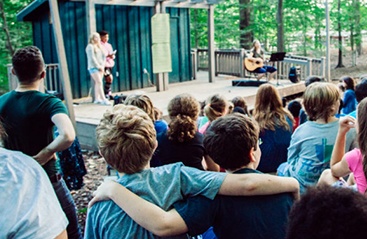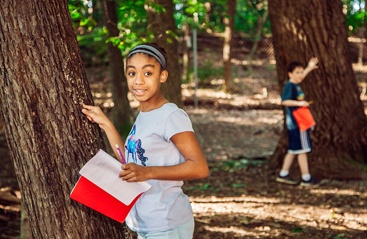
Lower School
We are so pleased with the whole-child education our daughter is experiencing at Burgundy Farm Country Day School. The focus on social, emotional, and academic learning encourages and supports each child to grow into their own unique self with great appreciation and respect for the world around them. The active and organic nature of the environment truly instills a love of exploration and learning in each and every child. From the classroom, to the campus, to the community, Burgundy is a unique and magical treasure for the children and their families.
– Jane H. T. and Michael S., current parents
First Grade at Burgundy
First Graders continue their journey towards becoming independent, creative, and productive thinkers and learners. Students are encouraged to work in groups, to share their work, and to ask questions. In First Grade they learn the value of living and working in a community and they are responsible for classroom jobs. They also learn how to support each other, solve conflicts peacefully, and advocate for their social, emotional and educational needs. A thematic approach is used to integrate all academic areas. Our two First Grade classes come together for snack, recess, field trips and special activities. Students enjoy their first visit to our West Virginia Cove campus which happens during the spring of First Grade. Parents from each family accompany the children on this overnight trip.
LANGUAGE ARTS
There is a wide range of reading and writing skill development in First Grade. Our challenge is to support and nurture each child on this continuum. Children meet in guided reading groups, do independent reading, and read with partners. They are encouraged to be active readers; they strengthen their decoding skills through both phonetic and whole language methods and hone their listening skills by hearing stories read aloud. They participate in book discussions that help develop their comprehension skills and Reader’s Theatre groups, giving them practice with fluency and reading for expression. Spelling and phonics instruction is taught using a combination of Orton Gillingham and Words Their Way. Burgundy First Graders become writers and illustrators starting on the first day of school! Emphasis is placed on the process of writing and the value of sharing our ideas through writing. They learn writing conventions, such as capitalization and punctuation, and incorporate many of the writing techniques from the books we read in our author and genre studies. First Graders also write poetry, write reflections in their journals, and use writing to record their work in math, science and social studies. Handwriting is taught using the Handwriting Without Tears program.
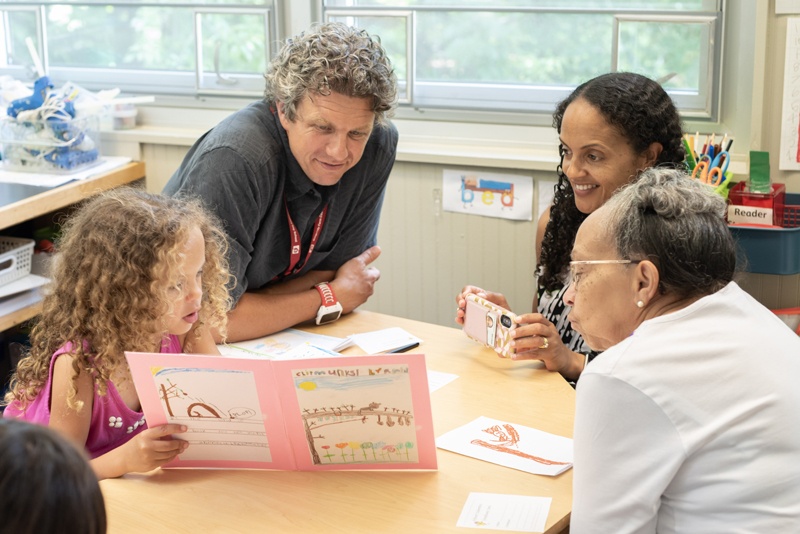
MATHEMATICS
Mathematics in First Grade is an active program that involves investigation, problem solving and analysis and we use TERC Investigations to help create this strong foundation of math skills. The goals in math in First Grade are to develop number sense, understand basic concepts, apply these concepts, develop skills in computation, and integrate math into other subject areas. An extensive variety of manipulative materials, such as Unifix cubes, pattern blocks, and Geoblocks are used by the children to gain number sense and to solve problems. They gain experience recording their work in a variety of ways such as using a math log. First Graders learn to organize and analyze data using graphs and charts. They use other organizational tools such as number lines, ten frames, and math racks. First Graders also use math in their daily routine, such as using the calendar, keeping track of the number of school days, and doing classroom surveys.
SCIENCE
Children are naturally curious about the world around them and our science program in First Grade helps to foster this curiosity using our 26-acre campus, monthly field trips, and our 506-acre Cove campus in West Virginia. Through active exploration, our First Graders learn the process of scientific inquiry using observation, identification, classification and comparison, and conclusion. Students observe, ask questions, and present their findings. Our broad science units include: wolves, earth science, brain and learning studies, farming and plant life. Within these broad units, children research and develop their own interests and topics using project-based learning. The First Grade science program correlates to our social studies curriculum and is enhanced by weekly sessions in our STEAM Wonderlab as well as visits to the Barn and community garden during our year-long Farm Study program.
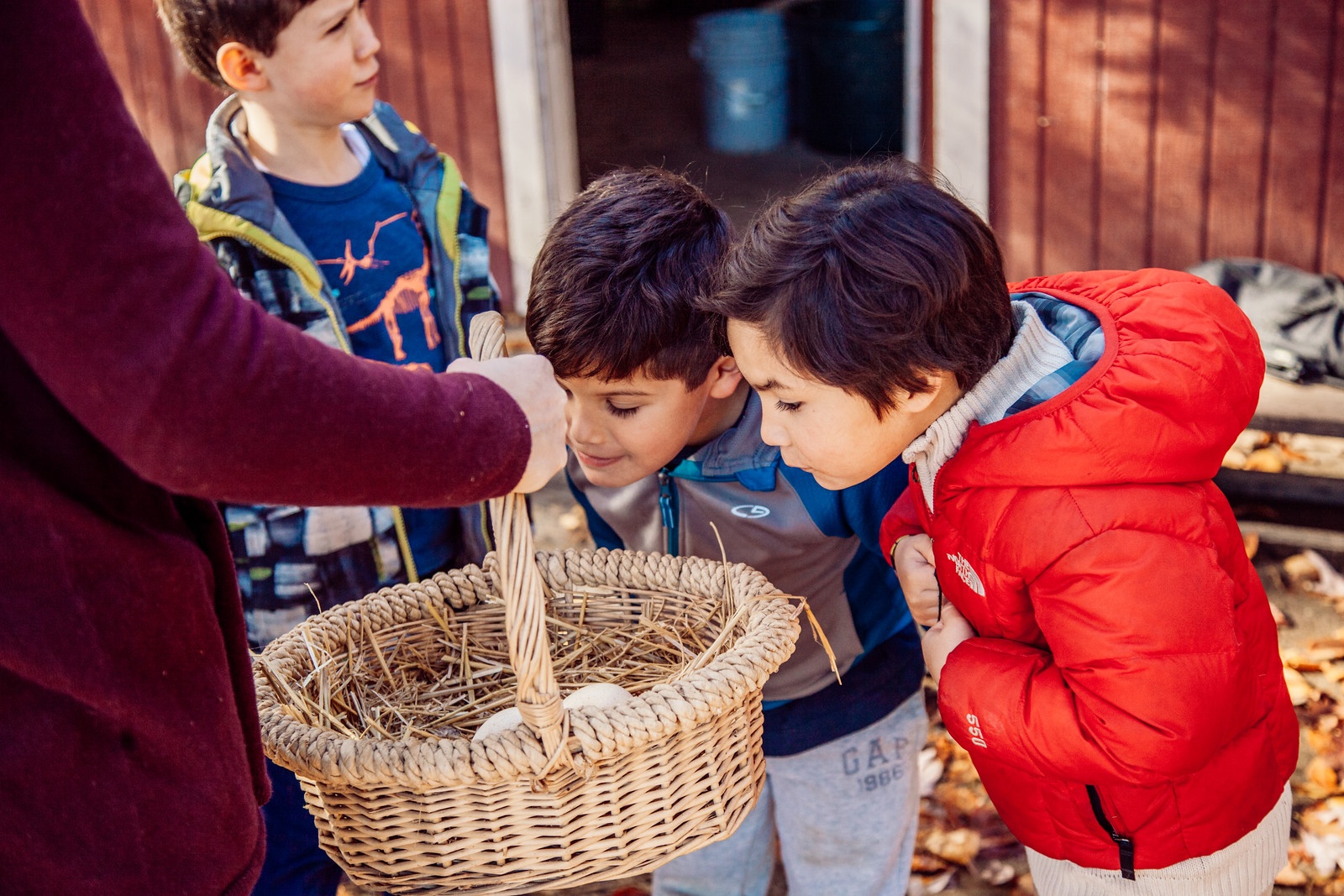
SOCIAL STUDIES
We continue to recognize and celebrate individual differences and to see the value of each student’s contribution to our classroom community. Conflicts are inevitable in any community and First Graders are given opportunities and strategies to recognize when conflicts happen and how to solve them peacefully, many of which come from the Connected and Respected curriculum. First Graders learn about the history of Burgundy using an interview process and timelines. They make and use maps in a variety of ways. In the winter they learn how to weave. Monthly field trips integrate with our social studies units that include: communities, maps and map making, weaving, quilts, and farm life.
WORLD LANGUAGE
At the beginning of First Grade, families choose either French or Spanish as the language their child will study for the duration of their time at Burgundy. Our world language program is designed to develop good pronunciation, listening, comprehension and speaking skills, provide vocabulary and introduce basic sentence patterns. Instruction is varied and includes songs, poems, craft projects, dialogues and games. First Graders have World Language twice a week for thirty minutes.
ARTS
Our music classes provide rich opportunities for students to learn concepts through experiences that build appreciation and knowledge of music and skills in expressing music vocally and instrumentally. They enjoy opportunities to sing and move to music, to learn the basic concepts of melody and rhythm through songs and games that are integrated into their thematic units of study. They begin learning musical symbols and notes and learn to play the recorder. This instruction further exposes the children to basic music theory and notation, providing the foundation to read music and play a pre-band instrument. First Grade students have music class twice a week for 30 minutes.
In the Lower School, drama instruction fosters the creative, critical and communicative potential of our students and enhances their capacity for creative expression while building poise and confidence, versatility in verbal expression, self-discipline, collaborative work and respect for others. Children become familiar with theater terminology and use structural components of story improvisation to develop theatrical skills. First Graders have drama once a week.
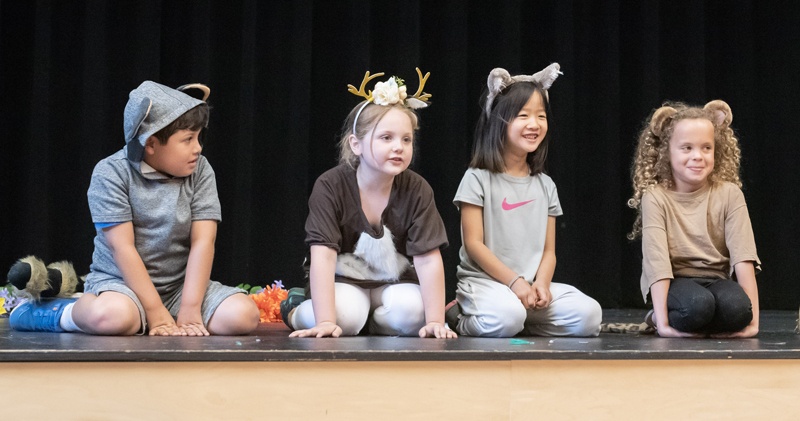
During their twice-weekly art class, First Graders use a variety of techniques and materials including markers, crayons, paints, ceramic clay, yarn, wire, wood scraps and recycled items to express themselves. Children are encouraged to share, discuss and describe both their process and finished work. Their art activities are often integrated into classroom themes. First Graders have art twice a week.

HEALTH AND WELLNESS
Healthy bodies and relationships are central to a healthy life. First Graders graduate to their own playspace just outside their doors and are given ample time throughout the day to take part in imaginative and active play. Students now have PE three times a week, making use of Burgundy’s heated, salt-water pool, full-size Gymnasium, wooded campus and athletic fields. Group games as well as more independent exploration encourage each child to develop and strengthen large motor skills. Conflict resolution skills continue to be emphasized. Students learn more about their bodies and how a baby begins using lessons from the Our Whole Lives program. Meditation is practiced as a method of teaching wellness and self-regulation as students learn about brain function and decision making.
Second/Third Grade at Burgundy
Children in Second and Third grades are eager to learn and take on new responsibilities. Our goal is to encourage this development by guiding their growth toward becoming independent and confident learners, as well as involving them in cooperative group projects and problem-solving activities. We want to continue to develop their sense of wonder and guide them in learning to evaluate their own progress.
There are approximately 28-30 students in each grade level class with two co-teachers and a full-time lower school Science teacher who works with students in grades 2-5. Students loop with their teachers for two years, which allows strong relationships to form and for teachers to better honor the development of each child. Homeroom-based studies includes language arts, social studies, and social and emotional learning. Instruction is offered in a variety of formats: half class, small group, individual instruction and occasionally, whole class. Mindful and flexible grouping is based on student readiness, interest, and/or learning style.
LANGUAGE ARTS
The goals of our reading program include: the development of decoding and comprehension skills, and the use of a variety of materials to gain information, while fostering in children the growth of confidence, independence, and enjoyment while reading. The reading program includes small group instruction with a teacher, small group interaction with teacher supervision, and individualized silent reading instruction. Multisensory instruction in phonics and word attack strategies serves to solidify decoding and fluency skills. Comprehension strategies and critical thinking skills are addressed through small group discussions and independent writing activities. There are daily read-aloud periods during which teachers read works of literature, many of which are related to the science and social studies curriculum. During our non-fiction units students work to understand key details, use text features effectively and determine main ideas. As students become more competent readers, the focus changes from strategies and skills that help them read to using reading as a tool to learn new information and enjoy stories.
Children learn the writing process and work to increase their stamina for writing. They generate and organize their ideas before writing a rough draft. An emphasis is placed on getting ideas down on paper with clarity and creativity. Rough drafts are revised after conferencing with a teacher. Editing for spelling and the mechanics of writing takes place prior to publishing and sharing of the final drafts. They work to create a full paragraph and then move on to multi-paragraph essays as they become more skilled. Throughout the process of writing, small mini-lessons and Daily Language Instruction address issues of language and vocabulary, grammar, the mechanics of writing, and spelling. Writing is integrated across the curriculum. Research reports related to themes in science and social studies provide opportunities for focused academic writing.
Spelling is an integral part of the language arts program and the Words Their Way spelling series is used. Instruction involves the study of phonics and spelling patterns, and strategies for applying them in daily writing. Handwriting instruction, using the Handwriting Without Tears materials, continues in 2/3 as children review and practice the manuscript alphabet before moving into the cursive alphabet.
MATHEMATICS
The goals of the mathematics program are to understand basic number concepts, apply conceptual knowledge with growing flexibility, develop skill in computation and problem solving, and develop confidence and an appreciation for the use of math in everyday life. Children attain, explore and discover mathematics principles using manipulatives, and by working together to solve practical problems before moving to independent work. Emphasis is placed on articulating ideas and strategies, and applying math in the everyday world. Students learn to express computational work clearly on paper, in addition to mental math strategies. They also learn strategies for committing basic math facts to memory and practice them through math games. Lastly, they gain confidence and skill with communicating their mathematical understanding, both orally and in writing. Instruction is generally conducted by grade level although at times during the year students will explore math projects in mixed-age groups. Second grade units include: place value, geometry, measurement, fractions, graphing, addition and subtraction, and multiplication and division. Third grade mathematics units include: multiplication, division, solving perimeter and area problems, 2- and 3-D geometry, and modeling data with graphs and line plots. The TERC Investigations math curriculum is used. Supplemental materials are used to provide additional practice or enrichment as needed.
SCIENCE
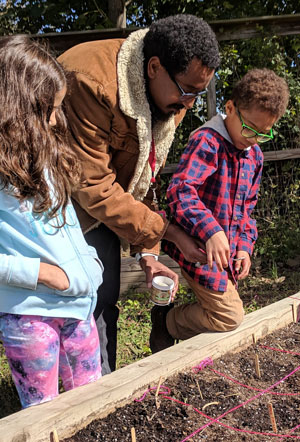 In our 2/3 program, students are taught by a science specialist in an alternating year theme-based curriculum. Students gain a deeper understanding of scientific concepts, apply concepts with growing confidence, develop observational skills and the ability to communicate information, and learn to use scientific processes with increasing facility. Our overall goal in 2/3 science is to foster curiosity and the awareness of science all around us, and help children develop a process for scientific inquiry. The formal science program deals with the natural and physical sciences, using exploration, hands-on activities and field trips. Topics of instruction include ecosystems, life cycles, ecology, adaptation, habitats, flora and fauna in addition to energy, light, matter, change, water, magnetism, weather, space and electricity. Children work in small groups and individually to gain hands-on experience. Throughout the year we utilize the unique resources found on the Alexandria campus and at our West Virginia Cove campus. Students attend science class twice a week for 40 minutes.
In our 2/3 program, students are taught by a science specialist in an alternating year theme-based curriculum. Students gain a deeper understanding of scientific concepts, apply concepts with growing confidence, develop observational skills and the ability to communicate information, and learn to use scientific processes with increasing facility. Our overall goal in 2/3 science is to foster curiosity and the awareness of science all around us, and help children develop a process for scientific inquiry. The formal science program deals with the natural and physical sciences, using exploration, hands-on activities and field trips. Topics of instruction include ecosystems, life cycles, ecology, adaptation, habitats, flora and fauna in addition to energy, light, matter, change, water, magnetism, weather, space and electricity. Children work in small groups and individually to gain hands-on experience. Throughout the year we utilize the unique resources found on the Alexandria campus and at our West Virginia Cove campus. Students attend science class twice a week for 40 minutes.
FARM STUDIES
Students participate in a weekly session with our caretaker at our barn and community garden. There they get hands-on experience in caring for our animals, which include miniature horses, chickens, sheep, goats and ducks, planting and tending a garden, and seeing how the animals and the plants are connected in a natural cycle. They explore animal physiology, compare and contrast domestic and wild animals, and learn about farming and food production.
SOCIAL STUDIES
The 2/3 program has an alternating year, theme-based curriculum. In Year One, the focus is on the. In Year Two, the focus is on the continents and countries around the world. An appreciation of diverse cultures is fostered and students are encouraged to share their own cultures and celebrations. Our studies come alive for children through music, folk tales, and literature. Through cooperative activities and trips to museums or theater productions, children learn firsthand about the lives of the people they are studying. Geography and map skills are taught throughout the two-year cycle. Language arts, history, math, technology, and science are integrated into our social studies units.
WORLD LANGUAGE
Students in Second and Third Grade continue their world language instruction in either French or Spanish. Reading and writing the world language is introduced although the emphasis is still on comprehension, speaking and cultural studies. New songs, games, poems and dialogues, as well as short stories and plays, reinforce and expand their skills. Second and Third Grade students meet for World Language class twice a week for 40 minutes.

ARTS
Our music classes provide rich opportunities for students to learn concepts through experiences that build appreciation and knowledge of music and skills in expressing music vocally and instrumentally. From Second Grade on, each student has a five to six week unit of piano instruction during their regular music class in our piano lab. Our formal instrumental music program begins in Third Grade where students choose to play a woodwind instrument (saxophone, clarinet, oboe, flute), a stringed instrument (violin or viola) or the trumpet. Students receive semi-private instruction (an average of four-to-one student to teacher ratio) once a week for their selected instrument. Burgundy provides the instruments for our students. Second and Third Grade students have music class twice a week for 40 minutes.
In the Lower School, Drama instruction fosters the creative, critical and communicative potential of our students and enhances their capacity for creative expression while building poise and confidence, versatility in verbal expression, self-discipline, collaborative work and respect for others. Children become familiar with theater terminology and use structural components of story improvisation to develop theatrical skills. Second and Third Graders have Drama once a week for 40 minutes.

During Art classes, Second and Third Graders become more skilled in their use of materials introduced in previous years and more familiar with elements of color, line, shape, form, pattern, and texture. Projects include mask and puppet making, printmaking, cartooning, collage, construction, weaving, papier-mâché, wire sculpture, watercolor, painting and drawing. Children are encouraged to share, discuss and describe both their process and finished work. Their art activities are often integrated into classroom themes. Students have visual arts class once a week for 40 minutes.
HEALTH AND WELLNESS
As children grow we continue to adhere to the philosophy that healthy bodies and relationships are central to a healthy life. Second and Third Graders share a playspace with Fourth and Fifth graders that includes woods, climbing structures, and basketball courts. Students are given ample time for free play throughout the day, including a mid-morning and lunch-time recess. Students have PE three times a week, including one mixed-age class. They make use of Burgundy’s heated, salt-water pool, full-size Gymnasium, wooded campus and athletic fields.

Group games as well as more independent exploration encourage each child to develop and strengthen large motor skills. Students are introduced to a wider variety of sports including roller skating, basketball, floor hockey, soccer and rock climbing. Students continue to explore relationships, practice conflict resolution skills, review personal safety, and discuss the importance of demonstrating dignity and respect for all people. The Rights, Respect and Responsibility curriculum is used as a guide. Mindfulness continues to be practiced as a method of teaching wellness and self-regulation.
Fourth/Fifth Grade at Burgundy
The Fourth and Fifth Grade program is designed to provide a solid academic foundation for students’ transition to the upper grades, to build upon students’ intellectual curiosity and promote respect for themselves and others. It is an exciting time on their educational journey as their academic skills and intellectual capacity make them ready for more advanced learning. There are two separate 4/5 multi-age classes. There are approximately 28-30 students in each class, each with roughly half Fourth and half Fifth Graders. Students learn in mixed-age groups for most of their homeroom-based studies including language arts, social studies and social and emotional learning. Math is usually taught in groups assigned by grade level. Instruction includes a blend of whole-class, group, and individual instruction. Mindful and flexible grouping is based on student readiness, interest, and/or learning style. There are a total of five teachers in 4/5, two full-time teachers in each classroom and a full-time science teacher. For more information on multi-age teaching at Burgundy click here.
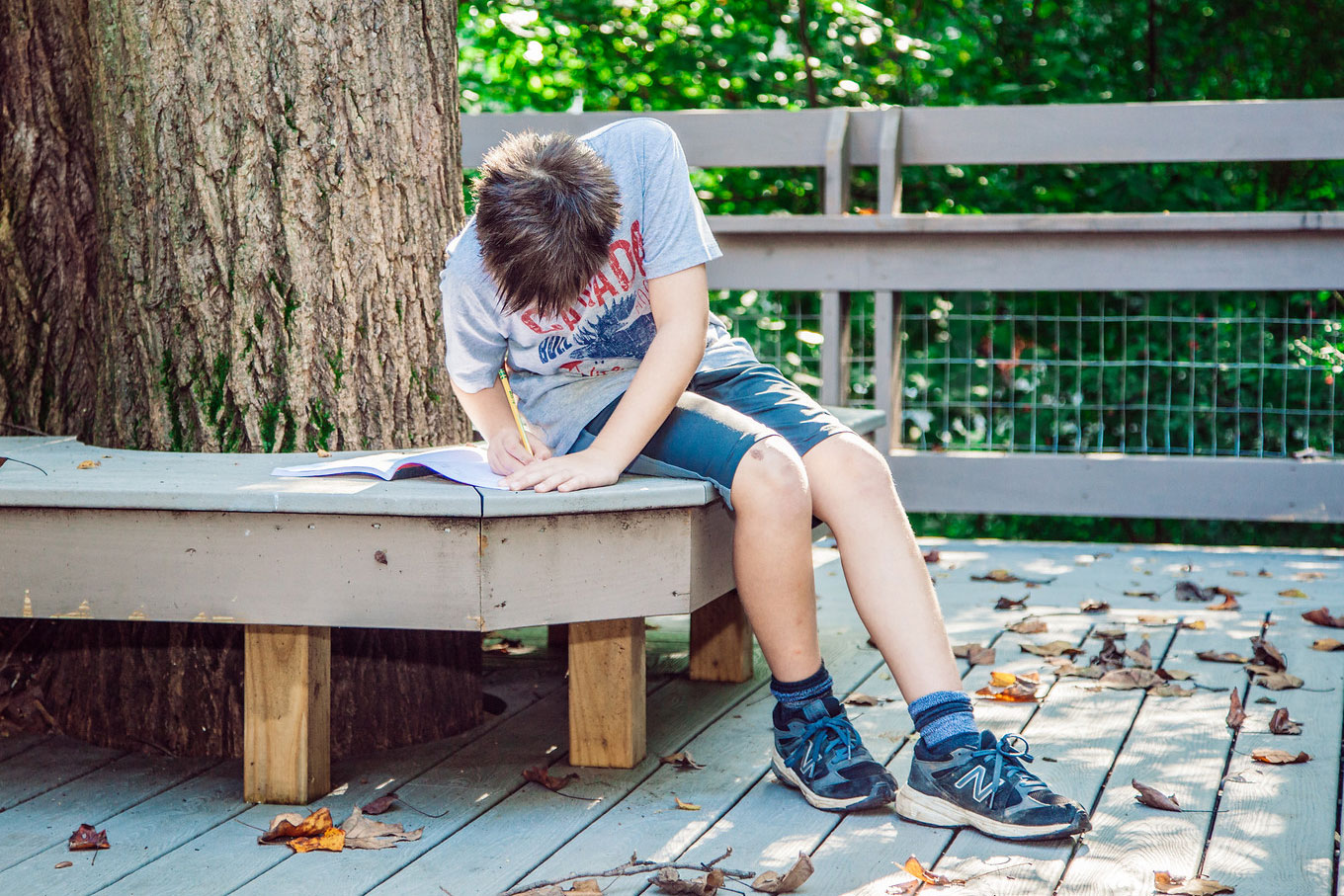
LANGUAGE ARTS
Fourth and Fifth Grade students develop their skills in reading for information and comprehension. Students build upon their love of reading by using age-appropriate, culturally relevant novels that are selected to broaden perspectives and stimulate curiosity about our diverse world. Students improve upon fluency and expression as well as identify main ideas and supporting details and summarize fiction and nonfiction text. Through group projects and novel assignment discussions, students learn to make inferences and predictions, read critically and identify new vocabulary. Sustained silent reading time and read-aloud sessions supplement the program. Students are exposed to a variety of writing experiences and learn to write for different audiences. Students learn the value of organization and form as they gather evidence to support and express an opinion on a variety of topics. Through each stage of the writing process, students learn to expand upon written composition skills to organize ideas into informative, persuasive, and creative works. Students build on their research writing skills, learning to summarize informational content in their own words. Additionally, students will use various resources to build upon skills in word study/spelling, grammar, vocabulary, sentence structure, and cursive handwriting. Students practice typing with an online program called Typing Club and use Chromebooks for much of their written work.
MATHEMATICS
The goals of the mathematics program are to understand basic number concepts, to apply conceptual knowledge with growing flexibility, to develop skill in computation and problem solving, and to develop confidence and an appreciation for the use of math in everyday life. Students learn to make sense of problems and persevere in solving them.
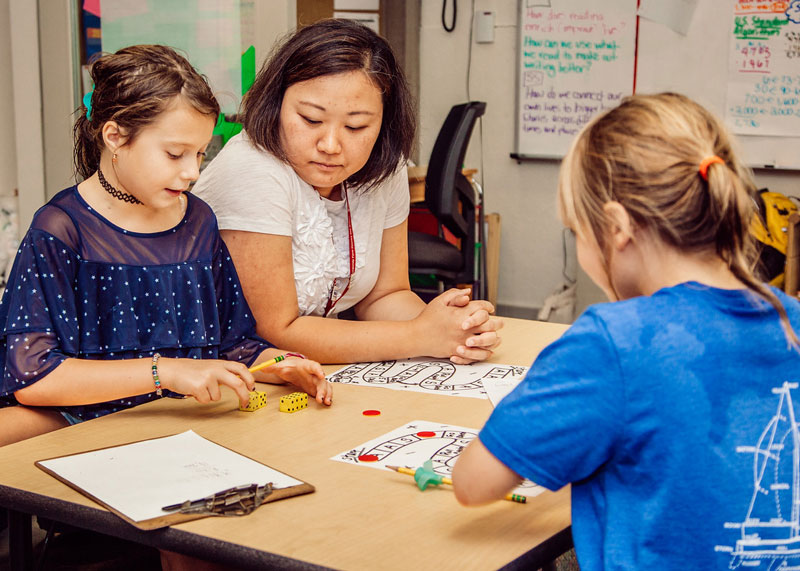
They learn to reason abstractly and quantitatively, construct viable arguments, and critique the reasoning of others. Students model with mathematics, learning to use appropriate tools strategically, and attend to precision. Instruction is generally conducted by grade level although at times during the year students will explore math projects in mixed-age groups. Concepts covered in fourth grade include: place value, number theory and estimation, multiplication and division with larger numbers, fractions, decimals, measurement, geometry, and multi-step computation strategies. Concepts covered in fifth grade include: geometry, patterns and graphing, multiplication and division with larger numbers, operations with fractions and decimals, and measurement. The TERC Investigations math curriculum is used. Supplemental materials are used to provide additional practice or enrichment as needed.
SCIENCE
In our 4/5 program, students are taught by a Science specialist in an alternating year theme-based curriculum. Over the two-year curriculum cycle, students study a variety of topics in the life, physical, earth and environmental sciences including: animal and plant cell structure, energy, simple and compound machines, biomes, and animal development. Students perform hands-on experiments through which they continue to develop an understanding of the scientific method. Students focus on making hypotheses, following written procedures, making detailed observations and drawing conclusions.

Students read science-based articles, both independently and in groups, for information and future discussion, improving their ability to extract and comprehend scientific information. In addition to written lab reports, students complete reports and projects on scientific topics, using resources from their classroom, the Internet and the school Library. Science-based documentary films and field trips, as well as the Burgundy barnyard, stream and pond, and our West Virginia Cove campus to supplement classroom learning. Fourth and Fifth Grade students attend science two times a week for 40 minutes.
SOCIAL STUDIES
The 4/5 program has a two year alternating, theme-based curriculum. During Year One, students focus on early cultures and peoples, ancient China and the Silk Road, Medieval Europe and the Renaissance. Year Two includes the study of Pre-Columbian cultures, the United States government, the Age of Exploration, Colonial America and the beginning of the American Revolution. Students read and take notes on social studies topics from a variety of sources. They learn the research process through at least one major report or study each year on an aspect of the culture studied, as well as various smaller projects. Students also participate in a number of simulations in groups, separating into clans, fiefdoms, ship crews, or towns as the culture being studied dictates. In these groups, students have roles and responsibilities, compromise and cooperate, and learn and improve leadership skills. Through this process, they gain a more complete understanding of the culture and time period. Culminating projects in these units have included dramatic representations and student-led expositions.
WORLD LANGUAGE
Students in Fourth and Fifth Grade continue their world language instruction in either French or Spanish. Reading and writing in the world language is emphasized along with comprehension, speaking and cultural studies. Students build upon their many years of language instruction and learn increasingly complex vocabulary and concepts. Games, poems and dialogues, as well as short stories and plays, reinforce and expand their skills. Fourth and Fifth Grade students meet for World Language class twice a week for 40 minutes. French classes meet in mixed-age groups.
ARTS
Our music classes provide rich opportunities for students to learn concepts through experiences that build appreciation and knowledge of music and skills in expressing music vocally and instrumentally. Each Fourth and Fifth Grade student has a five to six week unit of piano instruction during their regular music class in our piano lab. Students continue learning their chosen instrument (saxophone, clarinet, oboe, flute, violin, viola or trumpet) and receive semi-private instruction (an average of four-to-one student to teacher ratio) once a week. Burgundy provides the instruments for our students. Fourth and fifth grade students have music class twice a week for 40 minutes.
In the Lower School, drama instruction fosters the creative, critical and communicative potential of our students and enhances their capacity for creative expression while building poise and confidence, versatility in verbal expression, self-discipline, collaborative work and respect for others. Now familiar with theater terminology, story improvisation, and basic theatrical skills, students create and perform a dramatic presentation for an audience, usually integrated with one of their social studies units. Fourth and Fifth Graders have drama once a week for 40 minutes.
During art classes, Fourth and Fifth Graders become more skilled in their use of materials introduced in previous years and apply their knowledge of color, line, shape, form, pattern, and texture to their art. Projects include mask and puppet making, printmaking, cartooning, ceramics – using both wheel and slab techniques, collage, construction, papier-mâché, sculpture, watercolor, painting and drawing. Children are encouraged to share, discuss and describe both their process and finished work. Their art activities are often integrated into classroom themes. Students have visual arts class twice a week for 40 minutes.
HEALTH AND WELLNESS
 As children grow we continue to adhere to the philosophy that healthy bodies and relationships are central to a healthy life. Fourth and Fifth Graders share a playspace with Second and Third Graders that includes woods, climbing structures, and basketball courts. Students are given ample time for free play throughout the day, including a mid-morning and lunch-time recess. Students have PE three times a week, including one mixed-age class. They make use of Burgundy’s heated, salt-water pool, full-size Gymnasium, wooded campus and athletic fields. Group games as well as more independent exploration encourage each child to develop and strengthen large motor skills. Students hone skills in a variety of sports including swimming, rock climbing, basketball, archery, and soccer. Students continue to discuss healthy relationships and personal safety. They develop strategies for decision making and explore identity. Fourth Graders learn about changes related to puberty, while Fifth graders learn about reproduction. The Our Whole Lives program and Rights, Respect and Responsibility curriculum serve as guides. Mindfulness continues to be practiced as a method of teaching wellness and self-regulation.
As children grow we continue to adhere to the philosophy that healthy bodies and relationships are central to a healthy life. Fourth and Fifth Graders share a playspace with Second and Third Graders that includes woods, climbing structures, and basketball courts. Students are given ample time for free play throughout the day, including a mid-morning and lunch-time recess. Students have PE three times a week, including one mixed-age class. They make use of Burgundy’s heated, salt-water pool, full-size Gymnasium, wooded campus and athletic fields. Group games as well as more independent exploration encourage each child to develop and strengthen large motor skills. Students hone skills in a variety of sports including swimming, rock climbing, basketball, archery, and soccer. Students continue to discuss healthy relationships and personal safety. They develop strategies for decision making and explore identity. Fourth Graders learn about changes related to puberty, while Fifth graders learn about reproduction. The Our Whole Lives program and Rights, Respect and Responsibility curriculum serve as guides. Mindfulness continues to be practiced as a method of teaching wellness and self-regulation.
Inquire Now
Burgundy is a one-of-a-kind independent school for Junior Kindergarten through 8th Grade. We believe children learn best in an inclusive, creative, and nurturing environment that engages the whole child.
3700 Burgundy Road
Alexandria, VA 22303
703.960.3431
Accredited by: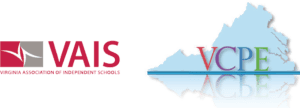
Affiliated with:
Partners with:
©2024 Burgundy Farm Country Day School
Designed and developed by The Design Channel![]()

